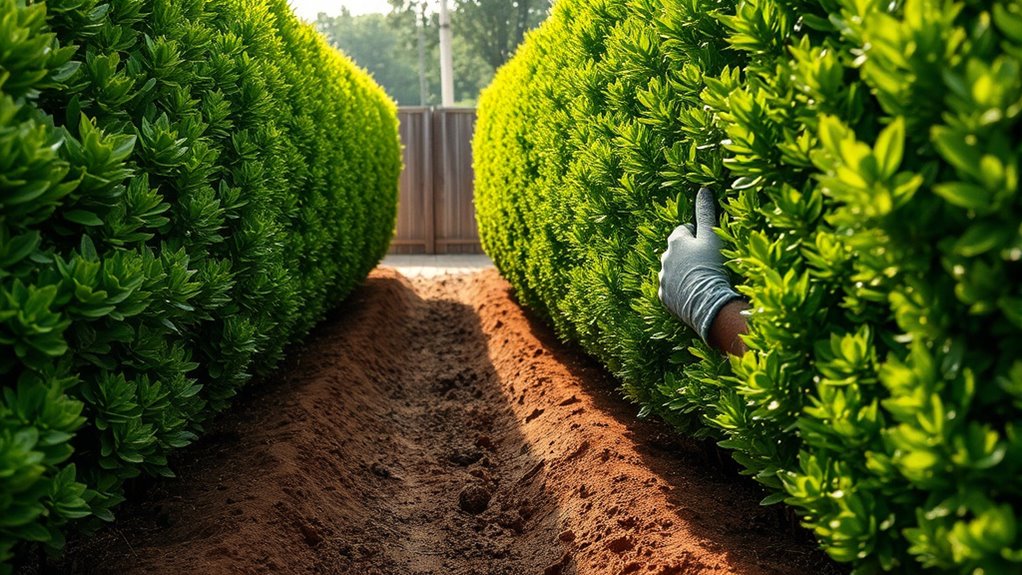To create a privacy hedge around your tiny lot, choose dense plants like arborvitae or boxwoods that provide year-round coverage, and mix in deciduous shrubs such as viburnum for seasonal privacy. Plant them close enough to form a solid barrier, but leave space for growth and maintenance. Layer different heights and textures to add visual interest. Regular pruning and proper care will keep your hedge healthy and attractive, and more helpful tips await if you explore further.
Key Takeaways
- Select dense evergreen plants like arborvitae or boxwoods for year-round privacy in small spaces.
- Plant close enough to form a solid barrier while allowing space for growth and maintenance.
- Incorporate layered heights and textures to create visual interest and depth.
- Use native or flowering shrubs to attract wildlife and enhance ecological benefits.
- Maintain the hedge through regular pruning, mulching, and monitoring for pests to ensure health and privacy year-round.

If you have a tiny lot and want to create a private outdoor space, a well-chosen privacy hedge can be an effective solution. On small properties, every inch counts, and a thoughtfully planted hedge not only shields your yard from prying eyes but also enhances your garden’s overall aesthetics. When selecting plants, consider those that blend beauty with functionality. Dense evergreens like arborvitae or boxwoods work well because they maintain their foliage year-round, providing consistent privacy. Alternatively, deciduous options such as viburnum or lilac can offer privacy during warmer months while allowing sunlight in during winter, adding variety to your garden’s visual appeal.
Designing a privacy hedge isn’t just about blocking views; it’s about creating a harmonious landscape that complements your outdoor environment. Focus on plants that fit the scale of your lot, avoiding overly aggressive species that could overwhelm limited space. Proper placement is key—plant your hedge close enough to form a solid barrier but with enough room for growth and maintenance. Incorporate layers of different heights or textures to add depth and interest, turning your hedge into a focal point rather than just a boundary. Well-maintained hedges can transform a cramped yard into a cozy retreat, balancing functionality with style.
Create a harmonious landscape by choosing appropriately scaled plants and layering textures for a stylish privacy hedge.
Beyond aesthetics, your privacy hedge can serve as a crucial wildlife habitat. Choose native plants that attract birds, butterflies, and beneficial insects, enriching your outdoor experience. For example, flowering shrubs like elderberry or serviceberry provide food and shelter for local fauna. Tall, dense hedges can serve as nesting sites and safe passageways for birds, supporting local biodiversity even in small spaces. By selecting plants that support wildlife, you turn your tiny lot into a miniature ecosystem, fostering environmental health while enjoying the privacy you desire.
Moreover, integrating AI-driven automation in garden management tools can help streamline maintenance tasks such as watering, pruning, and monitoring plant health, making it easier to keep your hedge thriving. Regular pruning keeps your hedge tidy and encourages healthy growth. Mulching around the base conserves moisture and suppresses weeds. Keep an eye out for pests and diseases, addressing issues promptly to maintain the hedge’s vigor. With proper care, your privacy hedge will thrive, offering year-round privacy, beauty, and ecological benefits.
Frequently Asked Questions
What Are the Best Evergreen Plants for Small Privacy Hedges?
You should choose compact evergreen plants like boxwoods or dwarf hollies for small privacy hedges. These options allow you to control hedge height easily, maintaining a neat appearance. Focus on plant density to guarantee full coverage, and space the plants appropriately to create a dense, effective barrier. Regular trimming helps keep the hedge at your desired height and thickness, providing privacy without overwhelming your tiny lot.
How Often Should I Prune My Tiny Lot Privacy Hedge?
You should prune your tiny lot privacy hedge about twice a year to maintain its shape and health. Stick to a regular pruning schedule, ideally in early spring and late summer, to encourage dense growth and prevent overgrowth. Keep hedge trimming frequency consistent, removing any dead or unruly branches, and avoid heavy pruning during the growing season. This way, your hedge stays neat, healthy, and provides ideal privacy.
Are There Low-Maintenance Hedge Options for Small Spaces?
Think of your tiny lot as a cozy cottage needing a simple, resilient shield. Drought-tolerant shrubs like boxwood or juniper make great low-maintenance hedge options, requiring minimal watering and pruning. For a splash of color, choose flowering hedge options such as spirea or viburnum. These options keep your space private and beautiful without demanding much effort, so you can enjoy your yard without constant upkeep.
Can I Plant a Privacy Hedge in a Shaded Area?
Yes, you can plant a privacy hedge in a shaded area. Focus on shade-tolerant shrubs like boxwood, holly, or yew, which thrive in low light. Avoid sun-loving hedges that need direct sunlight. You’ll want to prepare the soil well and choose plants suited for your specific shade level. With proper care, these shade-tolerant shrubs will grow into a lush, private barrier, even in limited sunlight.
What Is the Cost Range for Planting a Privacy Hedge?
The cost estimate for planting a privacy hedge typically ranges from $10 to $50 per plant, depending on the species and size. For a small to medium-sized hedge, budget planning should consider additional expenses like soil, mulch, and labor, which can add up. You might spend anywhere from $100 to $500 or more, so it’s wise to assess your space and choose plants accordingly to stay within your budget.
Conclusion
Now that you know how to plant a privacy hedge around your tiny lot, you’ll enjoy more seclusion and beauty in your outdoor space. Picture yourself relaxing behind lush, green foliage that naturally blocks out neighbors and noise. Isn’t it worth creating a cozy oasis right outside your door? With a little effort, your small yard can become a private retreat you’ll love spending time in every day. Ready to start planting your perfect privacy hedge?








